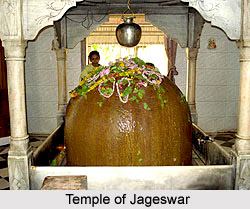 The Temple of Jageswar is located in the Iswar Gangi Street that is situated in the Ausan ganj Mahalla in Varanasi. Yajeswara is the `Lord of Sacrifice,` that is, Lord Shiva. By climbing a flight of steps, one can enter the outer court of the temple. Many shrines can be seen here in a row. Here an assemblage of small idols has been installed. This court forms a platform and is very spacious. The temple of Jageswar is located in a court of its own. It is surrounded by high walls all round.
The Temple of Jageswar is located in the Iswar Gangi Street that is situated in the Ausan ganj Mahalla in Varanasi. Yajeswara is the `Lord of Sacrifice,` that is, Lord Shiva. By climbing a flight of steps, one can enter the outer court of the temple. Many shrines can be seen here in a row. Here an assemblage of small idols has been installed. This court forms a platform and is very spacious. The temple of Jageswar is located in a court of its own. It is surrounded by high walls all round.
Architecture of Temple of Jageswar
The Temple of Jageswar occupies a large portion of the enclosure and has narrow space between it. This proved to be helpful for the worshippers who are able to carry out the custom of traversing the circumference of the temple. The portico rests on pillars. The floor of the temple is designed with small square slabs of polished marble. An image of a large bull called Nandi has been carved in the centre of the portico, facing the door of the temple. It the animal on which the god rides. Apart from the main temple there are two small shrines on either side located at the entrance to the temple from the portico.
The size and form of the idol of Lord Shiva is very appealing. The eyes of the Lord are diamond sparkling. The idol is made of an enormous block of stone that is round and black. It is six feet in height, and twelve in circumference. Being embellished with garlands, necklaces, bracelets, and many other valuable ornaments, the idol looks very pleasing to the eyes. There is a legend associated with the idol. It is said that on one occasion the gods had assembled to perform a great sacrifice. Out of the burning oblation issued Lord Shiva, in the shape of this stone. In the temple is a large spout that has been placed immediately over the idol below. The spout is kept filled with water during hot weather. It has one or more holes in the bottom and keeps which keeps dribbling upon the idol god and keeps him cool. Besides this temple there is a Karnghanta Talao, a tank named from the goblin Ghantakarna meaning `bell-eared.` It is also regarded as very holy by the devotees.





















